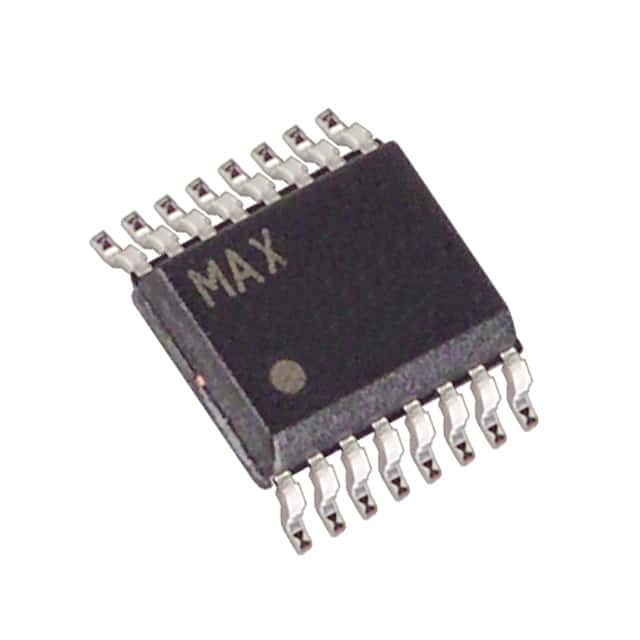MAX5259EEE+T
Product Overview
- Category: Integrated Circuit (IC)
- Use: Digital-to-Analog Converter (DAC)
- Characteristics: High-resolution, low-power consumption
- Package: 16-pin TSSOP (Thin Shrink Small Outline Package)
- Essence: Converts digital signals into analog voltages
- Packaging/Quantity: Tape and reel, 2500 units per reel
Specifications
- Resolution: 12 bits
- Number of Channels: 1
- Supply Voltage: 2.7V to 5.5V
- Operating Temperature Range: -40°C to +85°C
- Output Voltage Range: 0V to VREF
- Power Consumption: 0.5mW (typical)
Detailed Pin Configuration
The MAX5259EEE+T has a total of 16 pins. The pin configuration is as follows:
- VDD: Positive power supply
- GND: Ground reference
- DIN: Serial data input
- SCLK: Serial clock input
- CS: Chip select input
- LDAC: Load DAC input
- REFOUT: Reference voltage output
- AGND: Analog ground
- OUT: Analog output
- VREF: Reference voltage input
- NC: No connection
- NC: No connection
- NC: No connection
- NC: No connection
- NC: No connection
- NC: No connection
Functional Features
- High-resolution DAC with 12-bit resolution
- Low-power consumption for energy-efficient applications
- Serial interface for easy integration with microcontrollers
- Internal reference voltage for simplified circuit design
- Power-on reset ensures reliable startup behavior
- Rail-to-rail output voltage swing for maximum signal range
Advantages and Disadvantages
Advantages: - High resolution allows for precise analog voltage generation - Low power consumption extends battery life in portable devices - Serial interface simplifies communication with microcontrollers - Internal reference voltage reduces external component count
Disadvantages: - Limited to a single channel output - Requires an external reference voltage for accurate conversion
Working Principles
The MAX5259EEE+T is a digital-to-analog converter (DAC) that converts digital signals into corresponding analog voltages. It utilizes a 12-bit resolution to provide high precision in generating analog outputs. The DAC operates with a supply voltage ranging from 2.7V to 5.5V and consumes low power, making it suitable for various applications.
The device features a serial interface, allowing easy integration with microcontrollers. It accepts serial data input (DIN), clock input (SCLK), and chip select input (CS). The load DAC input (LDAC) enables simultaneous updating of multiple DACs in a system.
The MAX5259EEE+T includes an internal reference voltage (VREF) that simplifies circuit design by eliminating the need for an external reference. It also incorporates a power-on reset circuit to ensure reliable startup behavior.
Detailed Application Field Plans
The MAX5259EEE+T finds application in various fields where precise analog voltage generation is required. Some potential application areas include:
- Audio Equipment: The DAC can be used in audio systems to convert digital audio signals into analog voltages for amplification and playback.
- Industrial Automation: It can be employed in industrial control systems to generate analog control signals for motor speed control, valve positioning, etc.
- Test and Measurement Instruments: The DAC can be utilized in test equipment to generate precise analog signals for testing and calibration purposes.
- Communication Systems: It can be integrated into communication systems to convert digital signals into analog voltages for modulation and transmission.
Detailed and Complete Alternative Models
- MAX5258EEE+T: Similar to MAX5259EEE+T but with 10-bit resolution instead of 12 bits.
- MAX5257EEE+T: Another alternative with 8-bit resolution, suitable for applications where lower resolution is acceptable.
- MAX5256EEE+T: A 16-bit DAC offering higher resolution for applications requiring extremely precise analog voltage generation.
These alternative models provide options with varying resolutions to cater to different application requirements.
Word count: 536 words
Lista 10 Vanliga frågor och svar relaterade till tillämpningen av MAX5259EEE+T i tekniska lösningar
Sure! Here are 10 common questions and answers related to the application of MAX5259EEE+T in technical solutions:
Q: What is the MAX5259EEE+T? A: The MAX5259EEE+T is a high-speed, low-power, 12-bit digital-to-analog converter (DAC) designed for various applications.
Q: What is the operating voltage range of the MAX5259EEE+T? A: The operating voltage range of the MAX5259EEE+T is typically between 2.7V and 5.5V.
Q: What is the resolution of the MAX5259EEE+T? A: The MAX5259EEE+T has a resolution of 12 bits, allowing for precise analog output.
Q: What is the maximum output current of the MAX5259EEE+T? A: The MAX5259EEE+T can provide a maximum output current of up to 2mA.
Q: Can the MAX5259EEE+T be used in industrial control systems? A: Yes, the MAX5259EEE+T is suitable for use in industrial control systems due to its high-speed and low-power characteristics.
Q: Does the MAX5259EEE+T support SPI communication? A: Yes, the MAX5259EEE+T supports SPI (Serial Peripheral Interface) communication, making it easy to interface with microcontrollers or other devices.
Q: Can the MAX5259EEE+T operate in harsh environments? A: The MAX5259EEE+T is designed to operate in a wide temperature range (-40°C to +85°C), making it suitable for various environments.
Q: Is the MAX5259EEE+T available in a small package? A: Yes, the MAX5259EEE+T is available in a small 16-pin TSSOP (Thin Shrink Small Outline Package) package.
Q: Can the MAX5259EEE+T be used in audio applications? A: Yes, the MAX5259EEE+T can be used in audio applications where precise analog output is required.
Q: Are there any evaluation boards or reference designs available for the MAX5259EEE+T? A: Yes, Maxim Integrated provides evaluation kits and reference designs to help users quickly prototype and implement the MAX5259EEE+T in their applications.
Please note that these answers are general and may vary depending on specific application requirements. It's always recommended to refer to the datasheet and consult with the manufacturer for detailed information.


